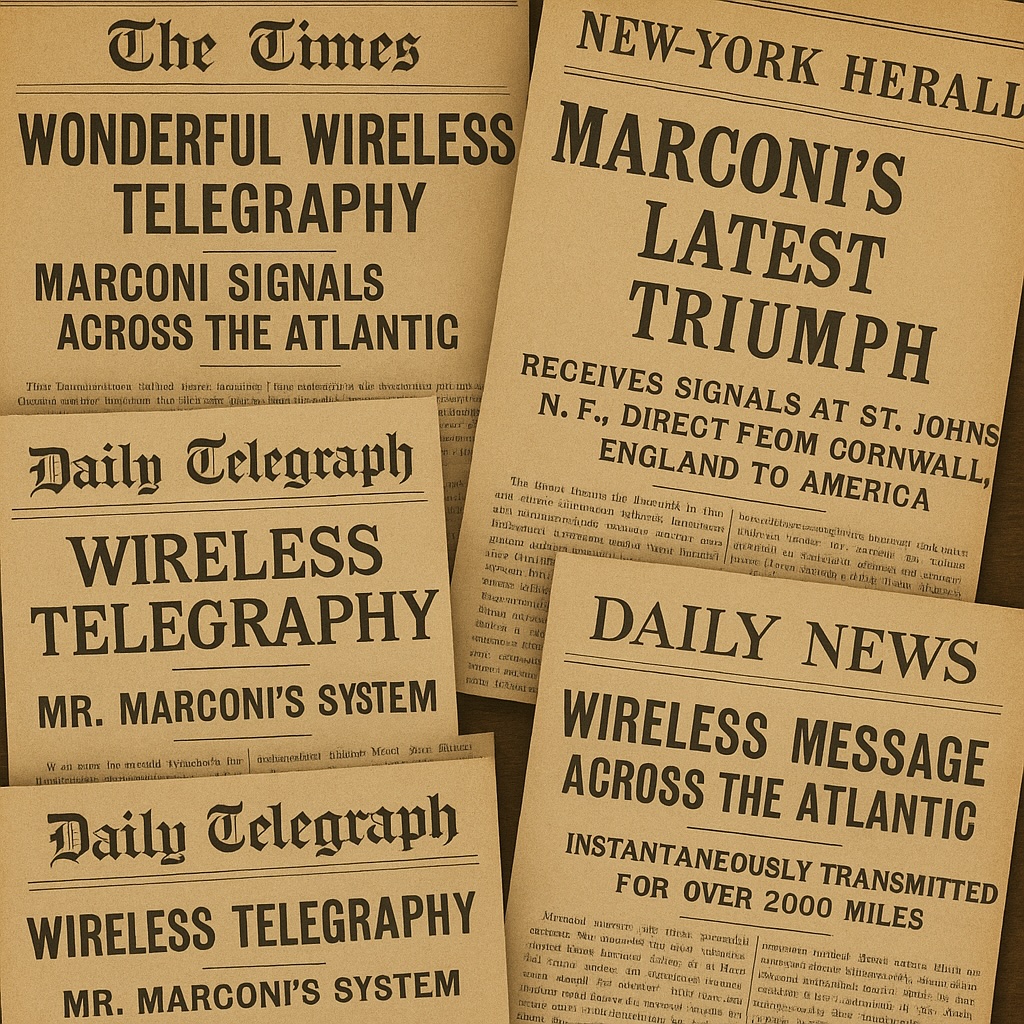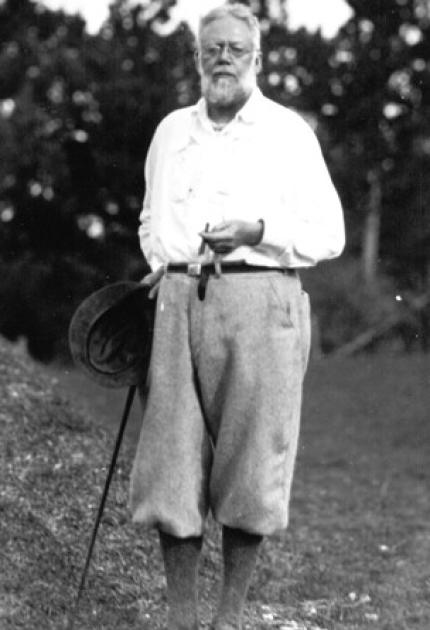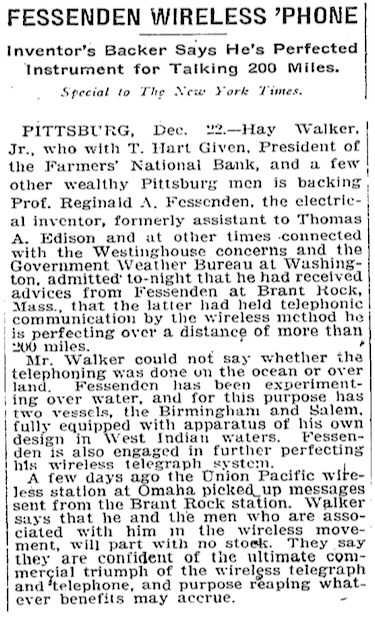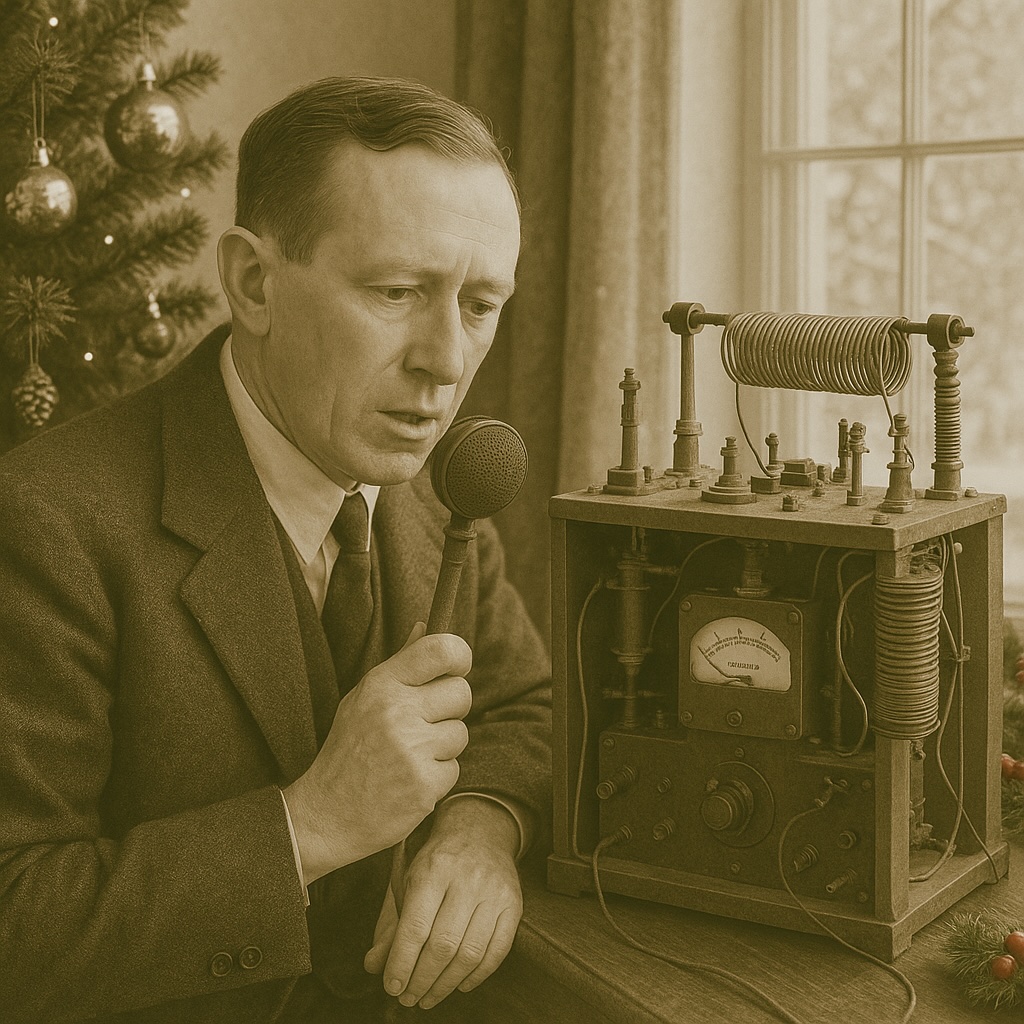Latest Awards
Trials & Errors #69 (11/21/25):The Man behind AM Radio

Have you ever considered how important it is for an inventor, or any business person for that matter, to be able to relate to the public? Today, we might call it being "media aware" but that could have a negative connotation. The term might remind you of a YouTuber posting click-bait, and that's the wrong way to look at it. The person who is media aware has a certain literacy that some of us don't possess, but it is a vital business skill that affects the success of his or her new technologies. Take Marconi as an example of what I mean.
The reason I bring this subject up in Trials and Errors is that I've been reading about two important developers of early radio technology. They each made very similar strides in radio, and yet the way they were recognized (and rewarded) was greatly different. I'm talking about Marconi and Fessenden.
Guglielmo Marconi was, within a few years of his discoveries, known all over the world. He was celebrated and given the keys to the city everywhere he went. He was extraordinarily involved in the public's perception of his work, to the point where he spent as much time on that element as he did in the furtherance of his radio technology.

On the other hand, another inventor with a similarly bright mind and over 300 patents, Reginald Fessenden (left) lived a considerably different life. He went from job to job with very little staying power, and throughout his life was known as a difficult and reclusive individual. One man (Marconi) knew about the care and feeding of the press, while the other shut his doors and developed a reputation as a recalcitrant inventor with a great dislike for publicity. Personally, I believe that this inability to share his enthusiasm for radio with the public made a huge difference in how Fessenden's life's work was perceived.
Marconi shared his passion for radio's benefits to society wherever he went. Fessenden, years later, seems to be only a footnote in radio's history. I believe this man deserves so much more!
Researching Fessenden requires real digging because he often let his exploits go without the fanfare that Marconi would have seen. Much of what I have learned here is from small snippets in the press of his day . . . short notices about advances that would have been front page news if it were Guglielmo Marconi.
A "Difficult" Work History
"Reg" Fessenden was a Canadian with an American citizenship as well due to a father who had roots going back to old New England. He was considered extremely bright, and as a young teenager taught mathematics to many others quite older than him. Unfortunately, he left college at age 18 -- without a degree. This left him quite difficult-to-employ in his early years. For example, he was passed over when applying for the Department Head for Electrical Engineering post at McGill University in Canada. It was then that he started seeking jobs in the world of private industry.
 Fessenden worked for Thomas Edison for a time, starting as a junior technician but quickly moving up the ranks until he worked in Edison's New Jersey laboratories alongside the master. Later, he worked for competitor George Westinghouse as well, securing a friendship and reference from Westinghouse due to his hard work in lighting the 1893 Chicago World's Fair. It's a shame that Reg didn't pick up any of the media savvy that both Edison and Westinghouse were known for . . . the Chicago fair was a major success for Westinghouse, as it showcased his Alternating Current electrical system. That was a technology being pushed by both Westinghouse and Tesla -- one opposed to Edison and his DC system. Fessenden's success with the World's Fair gave George Westinghouse the motivation to recruit him for an Electrical Engineering department chair post at what is now the University of Pittsburgh.
Fessenden worked for Thomas Edison for a time, starting as a junior technician but quickly moving up the ranks until he worked in Edison's New Jersey laboratories alongside the master. Later, he worked for competitor George Westinghouse as well, securing a friendship and reference from Westinghouse due to his hard work in lighting the 1893 Chicago World's Fair. It's a shame that Reg didn't pick up any of the media savvy that both Edison and Westinghouse were known for . . . the Chicago fair was a major success for Westinghouse, as it showcased his Alternating Current electrical system. That was a technology being pushed by both Westinghouse and Tesla -- one opposed to Edison and his DC system. Fessenden's success with the World's Fair gave George Westinghouse the motivation to recruit him for an Electrical Engineering department chair post at what is now the University of Pittsburgh.
Fessenden Turns to Radio
Professor Fessenden read about Marconi's early work with "radiotelegraph" in the late 1890's and came up with ideas to improve the spark-gap transmitter and receiver that had been developed by Marconi and Oliver Lodge. He believed that a continuous wave signal could offer so much more than the spark-gap, but that was a problem that would take a few years for him to percolate.
Reg's first experiments were to improve the receiving side of the process and within that year (1899) he had success with radio signals from Pittsburgh to Allegheny City (Pennsylvania) using an improved receiver design developed in his lab.  His interests in radio expanded greatly with an agreement he made with the US Weather Bureau where he proposed radio as a replacement for telegraphic weather reports.
His interests in radio expanded greatly with an agreement he made with the US Weather Bureau where he proposed radio as a replacement for telegraphic weather reports.
Fessenden set up a main station at Cobb Island, Maryland (80 miles from DC on the Potomac River) with several other stations along the coast. There he made a number of improvements in radio reception, with numerous resulting patents. This included his development of the heterodyne principle (which became much more important when the vacuum tube was invented about a decade later).
The idea of a continuous wave remained with him, however. The first demonstration of speech across radio came on December 23, 1900, when Fessenden transmitted between two towers about a mile apart on Cobb Island. He reportedly transmitted the message, "One, two, three, four, is it snowing where you are Mr. Thiessen? If it is, would you telegraph back to me?" He soon left the Weather Bureau due to issues about who owned his patents.
Private financial backers out of Pittsburgh came to Fessenden's aid when they formed a company (National Electric Signaling Company) based on his technologies to send speech over radio waves. His first attempt had used a spark-gap transmitter with an innovative modification that allowed the amplitude of the radio waves to be varied and carry the voice -- the first steps towards his invention of AM radio. While the transmission was difficult to understand, it was the first time intelligible human speech had been transmitted, proving that voice could be sent over radio. Once again, the implications on society were huge, but the press response was lacking in comparison to Marconi.
 The Disputed Christmas Eve Broadcast
The Disputed Christmas Eve Broadcast
Here's where the Fessenden story gets a bit fuzzy. As is commonly known, he patented many improvements to radio receiving, as well as developing AM radio. But he was also the first to use radio for broadcasting entertainment, and he used it to make an historic transmission of voice and music on Christmas Eve in 1906. As one website declares, he became "the World's First DJ."
He described the evening's entertainment as "First a short speech by me saying what we were going to do, then some phonograph music.... Then came a violin solo by me ... which I sang one verse of, in addition to playing the violin, though the singing, of course, was not very good. Then came the Bible text, Glory to God in the highest and on earth peace to men of good will, and we finally wound up by wishing everyone a Merry Christmas and then saying that we proposed to broadcast again on New Year's Eve."
120 years later and there are still those who deny it ever took place. On the matter of the Christmas Eve broadcast, you'll have to pick a side. I'll take the IEEE's word for it, and other well-known entities such as the National Inventors' Hall of Fame. After all, it's clear that Reginald Fessenden didn't have the media savvy to get much coverage of this milestone. But it should stand today as just another first out of this amazing radio inventor.
(Pardon the AI-generated graphic of a fellow speaking into an odd mic and radio. That's only meant to represent what occurred on December 24, 1906, and is historically inaccurate for radio/mic/human).
-
First voice transmission: In 1900, he successfully transmitted the human voice over radio waves.
-
First transatlantic radio communication: In 1906, he established the first two-way radiotelegraphic communication across the Atlantic Ocean.
-
First radio broadcast: On Christmas Eve 1906, Fessenden made the first radio broadcast of music and speech as entertainment.
-
Heterodyne principle: He developed the principle behind modern radio reception.
-
Continuous-wave transmitter: He invented a transmitter that produced continuous, pure sine waves . . . a key improvement over spark-gap systems.
-
Electrolytic detector: He invented a sensitive detector for receiving continuous radio waves, a key component for making radio more practical.
-
Fessenden oscillator: This device laid the foundation for modern sonar.
-
Fathometer: He invented the device which measures water depth.
-
Hydrophones: He helped develop hydrophones to detect enemy submarines.
-
Turbo-electric drive: He invented a turbo-electric drive for battleships.
-
Reflection seismology: His basic ideas led to this technique, used in the petroleum industry.
-
Other patents: Fessenden held hundreds of patents for inventions in various fields, including insulating tape, tracer bullets, and early concepts for television.
73 for now,
Dave, W7DGJ

Have a comment? See what others are saying now in our Forum discussion! CLICK HERE and JUMP INTO THE CONVERSATION
|
|
Dave Jensen, W7DGJDave Jensen, W7DGJ, was first licensed in 1966. Originally WN7VDY (and later WA7VDY), Dave operated on 40 and 80 meter CW with a shack that consisted primarily of Heathkit equipment. Dave loved radio so much he went off to college to study broadcasting and came out with a BS in Communications from Ohio University (Athens, OH). He worked his way through a number of audio electronics companies after graduation, including the professional microphone business for Audio-Technica. He was later licensed as W7DGJ out of Scottsdale, Arizona, where he ran an executive recruitment practice (CareerTrax Inc.) for several decades. Jensen has published articles in magazines dealing with science and engineering. His column “Tooling Up” ran for 20 years in the website of the leading science journal, SCIENCE, and his column called “Managing Your Career” continues to be a popular read each month for the Pharmaceutical and Household Products industries in two journals published by Rodman Publishing. |
Articles Written by Dave Jensen, W7DGJ
- Trials & Errors #69 (11/21/25):The Man behind AM Radio - November 25, 2025
- Trials & Errors #68 (11/04/25): The Value of YouTube vs. In-Person Elmers - November 4, 2025
- Trials & Errors #67 (10/10/25): Defending the Spectrum - October 11, 2025
- Trials & Errors Issue #66 (Sept 22 2005): High Water: Ham Radio's Role in 2004 Indian Ocean Tsunami - September 25, 2025
- Trials and Errors #65 (9/10/25): Defining the "Spirit of Ham Radio" - September 10, 2025
- Trials and Errors #64 (8/24/25): Tech-Focused Hams -- A Shot Across the Bow to ICOM, Yaesu and More - August 24, 2025
- Trials and Errors #63 (08/10/25): A Digital Radio "Plug 'n Play" Experience - August 11, 2025
- Trials and Errors #62: Celebrating Radio Innovation and Innovators - July 27, 2025
- Trials and Errors #61: The Carrington Event -- The "What If's" of our Sun's Activities - July 13, 2025
- Trials and Errors #60: How Shorthand Moved from Telegraphy to Ham Radio - June 30, 2025
- Trials and Errors #59: Misinformation Surrounding the Origins of "Morse" Code - June 10, 2025
- Trials and Errors #58: Tiny Radios and the Men Who Built Them - May 30, 2025
- Trials and Errors #57: Are We Erasing History? Thoughts on Clarence Tuska - May 16, 2025
- Trials and Errors #56: How I Earned My Radio Merit Badge But Almost Got Kicked Out of Scouts - May 4, 2025
- Trials and Errors #55: Radio's Role in the 1917 Halifax Explosion - April 29, 2025
- More articles by Dave Jensen, W7DGJ...



























